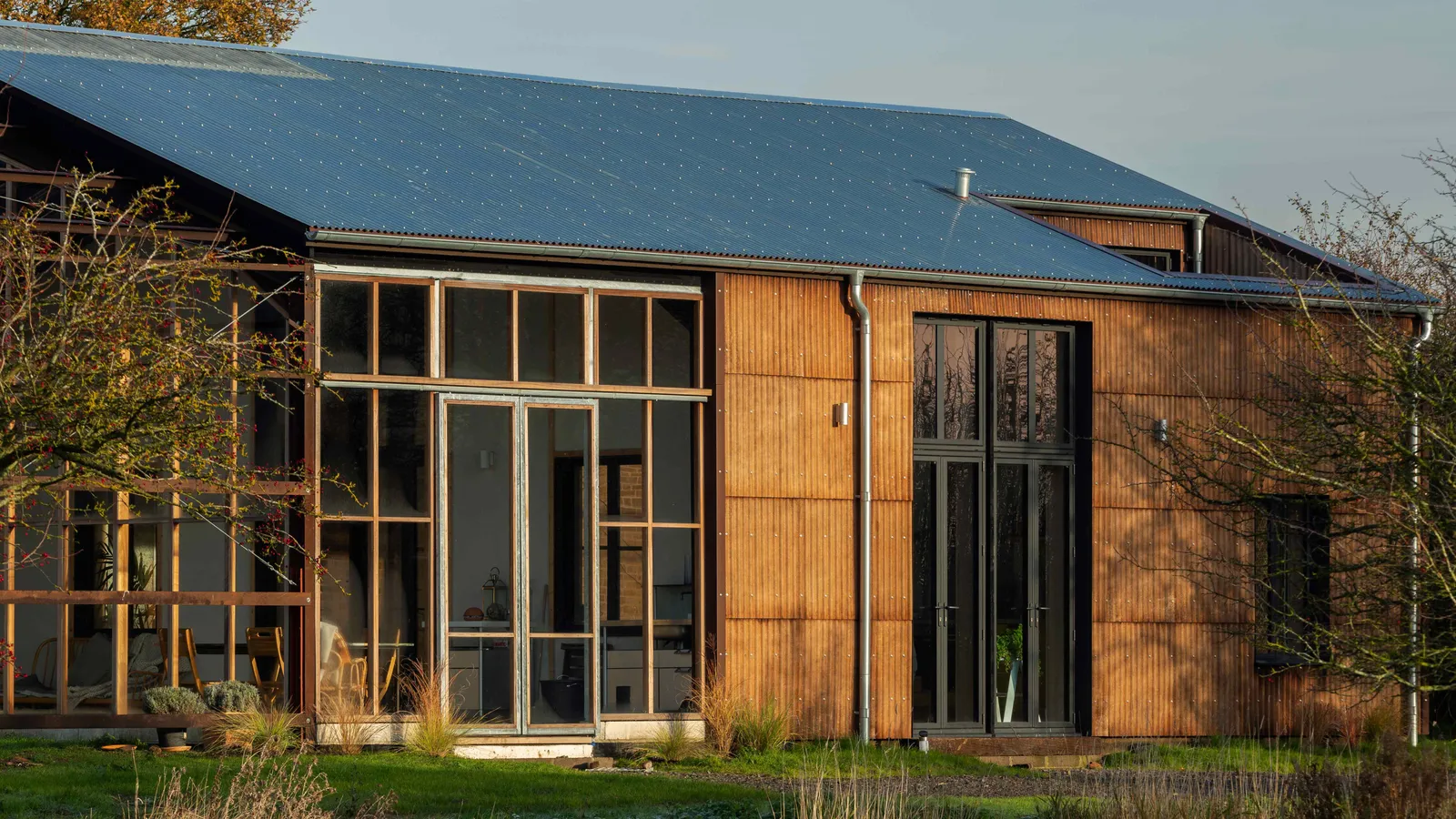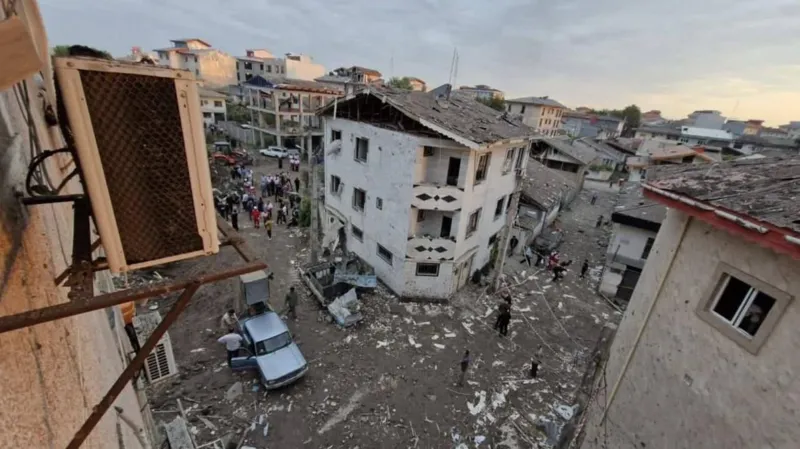The buildings constructed from cannabis
In search of sustainable materials, architects are turning to an unusual source: hemp.

Surrounded by verdant fields, Flat House, which sits on a farm in Cambridgeshire, the UK, looks like a typical barn conversion. But inside, the look and feel of the building immediately make you realise this is something quite different. "The walls remind me of hay bale dens we used to make as kids," says Flat House's owner Gemma Barron. "It has the most lovely acoustic quality. And last year we had the heating off for 24 hours in mid-winter and it stayed warm."
What makes this bright, airy and comfortable home unusual is the material used to build it: hemp. While we may be more familiar with the cannabis plant's association with the psychoactive substance cannabis, and its use in health supplements and textiles, hemp is rapidly becoming a sought-after sustainable construction material.
The fast-growing plant is a renewable resource, with carbon-capturing properties. When used in building, it typically takes the form of "hempcrete" (also known as lime hemp concrete), a sturdy material made by mixing hemp hurd – the woody core of the plant – with a binder made from water and lime. Hempcrete has a high thermal mass, making it an ideal insulation material which improves the energy efficiency of buildings and reduces greenhouse gas emissions over time. It also continues to absorb carbon over its lifespan.
Sustainable materials are in high demand as the construction industry seeks to decarbonise. Buildings and construction are responsible for approximately 37% of energy and process-related global carbon dioxide (CO2) emissions. This is due to the industry's heavy reliance on fossil fuels, including carbon-intensive materials such as concrete, steel and glass, as well as the greenhouse gases emitted in heating and cooling our buildings. (Read more: The concrete that helps the climate).
With its carbon capturing qualities, hemp could help countries reach their net zero goals by making construction more sustainable. "Optimising the way we design, construct, and renovate our buildings has a critical role to play in driving down emissions and enabling the UK to meet its climate targets," says Yetunde Abdul, head of climate action at the UK Green Building Council. "An important part of the solution involves exploring the use of natural, low-carbon alternatives to vital construction materials such as hempcrete or timber."
According to the European Commission, one hectare (2.5 acres) of hemp sequesters between nine and 15 tonnes of CO2, and only takes five months to grow – meaning it is better than typical commercial forestry at sequestering carbon. What's more, hemp production is reported to help regenerate soil and remove heavy metals from the ground.
But a whole host of challenges must be overcome before hemp can make its mark on the construction industry. These include changes to government regulation, technical certification, and the funding and infrastructure needed to scale up hemp's industrial production, streamline supply chains, and make it more affordable to use.
Today, in hempcrete form, the plant is used mostly by eco-minded architects with comfortable budgets in Europe and North America, mainly due to regulations controlling hemp production evolving in these regions. (It's worth pointing out that the industrial version of the plant does not contain the psychoactive agents of regular cannabis.)
Hempcrete does not work like concrete; it cannot be used structurally and so needs to be combined with load-bearing materials such as timber or stone. But as insulation, it offers a less carbon-intensive option than petrochemical-based materials such as fibreglass and foam board.
Hempcrete "does everything", says Summer Islam, co-founder of London-based Material Cultures, the research and design studio which built Flat House in 2020. "Its high thermal mass means it heats up and releases heat slowly, regulating interior temperature over the day." It's also hydroscopic, she adds, so it absorbs and releases moisture, making it good at regulating mould in buildings.
The hemp used for Flat House was grown on the surrounding land of Margent Farm. The project represents what Material Cultures calls "circular ecology", an approach to construction in which buildings emerge from, and can naturally reintegrate into, the landscape. Hempcrete has been used in pre-fabricated panel form to create the home's walls, fitted around a timber structure. Inside the house, the materials are left exposed, with the hay bale-like appearance of the hempcrete visible.
Could concrete be a climate saviour?
One drawback of hempcrete is that it deteriorates when left exposed to rainy weather, so Material Cultures needed to find a new solution for Flat House's exterior, while still harnessing the plant's full potential. Instead of the hemp hurd, the practice turned to the plant's stringy exterior, known as bast fibres, which are already used on an industrial scale to replace fibreglass in aerospace and car engineering.
Material Cultures thermally compressed these hemp fibres with a natural, sugar-based resin to create rain-resistant cladding panels which cover the house. The farm continues to produce these panels, with huge interest from other architects wanting to use the material.
Material Cultures is planning to continue using hemp in the new Phoenix Project in Lewes, East Sussex. Developed by Human Nature and conceived as a 700-home neighbourhood built with sustainability at its core, the project will use hempcrete alongside locally sourced timber in most of the buildings.
Hempcrete is no new invention; it has been used in buildings for thousands of years. However, the last century saw the rise of more modern construction materials and the criminalisation of hemp growing due to its association with the use of recreational cannabis.
One hectare of hemp sequesters between nine and 15 tonnes of CO2 and only takes five months to grow
In France, however, growing hemp was never outlawed, which contributed to the country becoming one of the global leaders in industrial hemp. Following the modern revival of hempcrete in the late 20th Century, a number of building projects using the material have been constructed around the country.
In 2020, a seven-storey block of social housing was completed in Paris, which harnessed hempcrete as the primary insulation material, accompanied by a timber frame. The architecture practice behind the project, Barrault Pressacco, had used hempcrete occasionally over the preceding decade, but this was its largest-scale deployment of the material.
Practice co-founder Thibaut Barrault describes hempcrete as "architecturally virtuous", praising its thermal performance, breathability, impacts on wellbeing, and carbon sequestration. It's not a perfect solution, though: "Hemp is great, but lime is still something that you should question as a sustainable issue," he says. The production of lime requires heating limestone to approximately 1,000C (1832F), which emits carbon.
The emissions from travel it took to report this story were 0kg CO2. The digital emissions from this story are an estimated 1.2g to 3.6g CO2 per page view. Find out more about how we calculated this figure here.
"There is no one solution to save the world," Barrault says – but for now, hempcrete remains a positive option. The practice is using it in a large residential and commercial building currently under construction in Paris, and is also researching if hempcrete can be used in retrofit projects. Retrofitting has become a vital way to upgrade and improve the energy efficiency of buildings without the huge carbon cost and waste of demolition and rebuilding. (Read more about the industry creating a third of the world's waste).
To date, hempcrete has primarily been used in small residential projects, due to issues around supply chains, scaling restrictions and cost. "Ultimately the manufacturing capacity in the UK isn't yet geared towards large-scale production," says Islam. "The machinery for it is very expensive and not distributed across the country." What's needed, she says, is investment – in businesses, infrastructure, skills and material certification. Until that happens, hempcrete will remain a costly and scarce material to work with, exacerbated by high insurance premiums due to it being classified as "non-standard".
Paloma Gormley, another co-founder of Material Cultures, argues the "huge amount of investment" from high-carbon material manufacturers into the approvals around their products has enabled them to dominate the market, both in terms of affordability and accreditation. "There's an equivalent process that needs to happen for materials such as hempcrete."
Legal regulation, even simply for growing hemp, is another huge roadblock. In the US, for example, industrial hemp cultivation was illegal until 2018, due to the plant being considered a controlled substance. Hempcrete itself was only approved for the country's residential building code in 2022; it remains prohibited from commercial projects until at least 2025.
In South Africa, hemp was finally designated an agricultural crop in 2021, enabling its cultivation in the country. Cape Town-based Wolf + Wolf Architects has made a name for itself in hemp architecture over the last 15 years, but until recently had to rely on imports of the plant. "I started working on my first hemp house in 2007," says practice founder and principal, Wolf, who only uses his surname. "I was fascinated by all its uses and could see the positive impact that it could have on the decarbonisation of the built environment."
Wolf + Wolf is currently completing a high-rise building in Cape Town using hempcrete in pre-fabricated block form, which is thought to be the world's tallest building constructed using the material.
The architecture practice is also currently working on four hemp houses and has started designing another tall hemp building. Wolf is optimistic: "The interest in South Africa for hemp as a building material is growing exponentially. It's the beginning of a whole new industry in the country."
Due to the unlocking of regulations, and increasing understanding of the material's myriad benefits, the use of hempcrete is on the rise, despite being concentrated primarily in Europe and North America. The European Commission has reported that the area of EU land dedicated to industrial hemp cultivation grew by 75% between 2015 and 2019, with France responsible for 70% of overall production.
Although other countries may be slower to embrace hemp as an agricultural product and building material, things may soon accelerate. In November 2022, the UN published a report outlining the benefits of industrial hemp. The UN advised that to fully exploit hemp's potential, countries would need to clarify the plant's legal status, confront the constraints of regulatory frameworks, and cooperate regionally to facilitate the establishment of production chains.
Material Cultures believes adopting sustainable building materials such as hemp could form part of a shift towards a building approach in which locally sourced natural resources are used. "Which includes getting most of your building mass from fast-turnover crops, as a way of providing low-carbon insulation, but also capturing and storing carbon in buildings," says Gormley.
Although what the environment truly needs is a dramatic reduction in construction, what's important is that when you do build, "you do it in resource-efficient, lean and considered ways," says Islam. Fast-growing and carbon-sequestering hemp, then, looks like an ideal material to harness.
-bbc







